National Churches: Romania, Bulgaria, Serbia, Albania
WEEK 3: ROMANIA, BULGARIA, SERBIA, ALBANIA
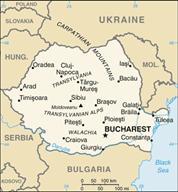 Try to spend a bit of time on each country, maybe with a student preparing each section in 5 minutes as before. At the end, take some time to compare and contrast these interesting but little-known countries.
Try to spend a bit of time on each country, maybe with a student preparing each section in 5 minutes as before. At the end, take some time to compare and contrast these interesting but little-known countries.
ROMANIA
Geography:
Romania, meaning land of Romans, lies in Eastern Europe. They are the only Eastern European people to trace their ancestry back to the Romans and to speak a Romance language and not a Slavic one. The Western alphabet is used, not the Cyrillic. Bucharest is the capital and largest city.
Mountains of the Carpathian Ranges curve through Romania, providing beautiful scenery and hiking trails, as well as skiing in the winter. And the sunny Black Sea coast has dozens of sandy beaches. The Danube River flows along Romania’s southern border. Romania has fertile soil, vast forests, and mineral deposits, yet is one of the poorest countries in Europe.
History:
Romania was first settled by the Dacian people in 300 BC. The country was called Dacia at this time. The Romans, under Emperor Trajan, conquered Dacia in 106 AD. The Dacians adopted Roman customs and the Latin language. Barbarians forced the Romans to abandon the country in the late 200s. Huns, Goths, Bulgars, Slavs, and Tartars – all marched back and forth across Romania all the way till the 1100s. For hundreds of years various groups invaded and fought for control of the region. Finally, around the year 1300, the Walachians in the south and the Moldavians in the east formed principalities. Hungary took and held Transylvania.
Romania, like all the Balkan countries, suffered under the Turks. The Walachians were conquered in 1476 and the Moldavians in 1504. The Turks ruled for 300 years. The peasants, who were poor and hungry before, had to pay huge taxes to the Turks. When Russia defeated Turkey in 1829, the Romanian provinces of Moldavia and Walachia were liberated. In 1862, these two provinces were recognized by the rest of Europe as the Nation of Romania.
Romania sided with the Allies in World War I and, at the end of the war, received back from Austria-Hungary the provinces of Transylvania, Bukovina, and Banat with largely Romanian citizens.
In World War II, Romania tried at first to remain neutral. Bulgaria bit off a piece of Romanian territory in the south, the Soviets bit off a piece in the north, and Hungary grabbed back northern Transylvania. Fed up, Romania first sided with the Germans, then with the Allies. In the end. Bulgaria and the Soviets kept their pieces, but Transylvania was returned to Romania. Soviet troops remained in Romania until the late 1950s, after which the Communist party in Romania took over the government. Romania remained under Communist rule until 1990.
Romanian Orthodox Church:
The Romanian Orthodox Church had its beginnings with the missionary work in the 9th century of Sts. Cyril and Methodius. Review their story in the Slavic lessons. Because of this, the Romanian Church has always been under the jurisdiction of the Patriarch of Constantinople. In 1885, Romania received autocephaly (self-government) from the Patriarch and, in 1925, the Metropolitan of Bucharest was elevated to Patriarch.
As Romanian Orthodox emigrated to America, Romania, too, founded churches for their people. Today, some of these parishes retain their ties to the Patriarch of Bucharest, while many have joined the OCA.
Ethnic traditions:
The Romanians constructed over the centuries beautiful churches and painted beautiful icons. Being forbidden by their rulers to paint icons on wood, the artists developed the fine art of painting on glass. Have one of our people who traveled to Romania in 2002 show you pictures of the churches and examples of the icons. We have 2 Romanian families who can share with you Romanian food, clothing, music, etc. The Romanians grilled meats, especially ‘mititei,” meatballs shaped like cylinders, and “patricieni,” sausages. Another favorite food is a bread or mush made of corn meal called “mamaliga.” Wine and a plum brandy called “tzuica” are popular drinks. Folk dancing is colorful and quick, with red and white traditional costumes.
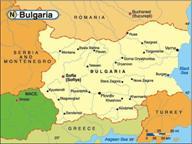
BULGARIA
Geography:
Bulgaria is sandwiched between Romania and Greece, with the Black Sea on the east. The Danube River forms its northern border. Its capital is Sofia. The terrain is mostly mountainous, but with fertile valleys between. The climate is mild on the coast, with temperate summers.
History:
The earliest inhabitants of Bulgaria, the Thracians, were conquered by the Romans in 40 AD. Rome ruled until the 6th century, when the “barbarian” Bulgars (a group of Huns – remember Attila?) and Slavs took the land. In 681 the first Bulgarian kingdom was established; it became the most powerful state in the Balkans and reached a “golden age” of trade and art under Simeon I in 893. In 1018, in decline after Simeon’s death, the Bulgarians were conquered by the Byzantine Empire. In 1186, Bulgaria regained its independence. During the 1200s, Bulgaria was again the dominant Balkan power.
But, Bulgaria, also, was conquered by the Ottoman Turks in the late 1300s. Many Bulgarians who opposed their rule were killed. The story of St. Zlata tells of one of these martyrs. Russia helped Bulgaria gain independence from the Turks in 1878 and Bulgaria became a nation in 1908 under King Ferdinand. But, under the treaties of the Balkan Wars, Bulgaria lost much of its land. It entered World War I on the side of Germany, intent on regaining its lost territory. But, with the defeat of Germany, Bulgaria lost even more land. The same thing happened in World War II. The Soviets invaded in 1944 to defeat the Germans and in 1946, Bulgaria came under Communist rule. In 1990, after a decade of demonstrations, the Communist Party was overthrown.
St. Zlata:
Zlata lived in the village of Slatina in the country of Bulgaria. She was very poor, but loved Jesus with her whole heart. She was also beautiful and kind. All the village loved Zlata.
In those days, the Moslem Turks ruled Bulgaria. They hated all Christians. One day, a Turk saw Zlata as she was gathering firewood for her family. He decided he wanted her for his wife and captured her. He took her to his home. There he decided she must first becom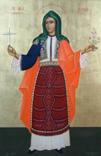 e a Moslem before he could marry her. But Zlata would not deny Jesus Christ her Lord.
e a Moslem before he could marry her. But Zlata would not deny Jesus Christ her Lord.
The Turk promised Zlata riches and slaves to do her work for her. But, she would not deny Christ. She told him that she was waiting for the mansion in heaven Jesus promised. Then the Turk threatened her with terrible tortures, but she told him she was not afraid to suffer for Jesus. Then he had her live for six months with his Turkish women; they tried to trick her into denying Jesus and even tried magic. But nothing would get Zlata to deny Jesus. The Turk then went to her family and told them they would all be killed if she did not become a Moslem. They tried to get Zlata to at least pretend to be a Moslem, but she told them that she would not lie to God.
The evil Turk was beaten. He tortured Zlata, but all she did was pray. The Turk was furious. He hung her in a tree and cut her into pieces. So St. Zlata became a martyr and went home to heaven with her beloved Jesus.
Bulgarian Orthodox Church:
Missionaries and disciples of Sts. Cyril and Methodius traveled to Bulgaria sporadically. The Cyrillic alphabet was used and Slavonic was their own language. But, King Boris began the systematic conversion of the Bulgarian people to Orthodoxy and declared Christianity to be the state religion in 865 AD. He is recognized as “Equal to the Apostles” for his work in spreading Christianity within his nation. He took the baptismal name of Michael and is thus sometimes called Boris-Mihail. Boris dreamed of his own nation, separate from the Byzantine Empire, and hoped by requesting his own independent Orthodox Church to make
that a reality. Finally, in the mid-10th century, Bulgaria was recognized as the first independent Slavic nation. And the Bulgarian Liturgy is continued today in the Orthodox churches using Church Slavonic, ancient Bulgarian! Boris stepped down from the throne in favor of his son Vladimir and retired to a monastery. However, when Vladimir began a return to paganism, Boris returned, defeated his son, and placed another son, Simeon, a Christian, on the throne. He ended his years as a monastic.
One of the foremost theologians of the 12th century was Theophylactus, Archbishop of Ochrida. He wrote commentaries on the Old and New Testaments; his most important work, however, was entitled, “On the Error of the Latins.”
In the later 12th century, a heretical group of Dualists (who believe in two Gods, good and evil) called the Bogomils shook the Church. The Bogomils, naturally, rejected both Eastern and Western Christianity and were declared heretics by the Byzantine Church. While they shook the Bulgarian church for nearly 100 years, eventually their influence and numbers dropped off.
After the sack of Constantinople, when Latin kings were ruling the Empire and sat in the Patriarchal seat, Prince Kaloyan of Bulgaria was given the title of Bulgarian Tsar by the Pope. He promised loyalty to the Pope in return. But, the clergy and people wanted to remain Orthodox and the union did not last long.
In 1235, the Bulgarian Prince was recognized by the Byzantine Emperor as Tsar and the ancient Patriarchates recognized the Bishop of Bulgaria as Patriarch. The Bulgarian Church was independent. The Church was allowed to continue its worship under the Turks, although in a limited way.
After the Macedonian revolution in 1903, Bulgarian immigrants began to come to America. Small Bulgarian mission parishes sprang up. These were declared a diocese with a bishop under the Bulgarian Patriarchate in 1938. Today, some Bulgarian Orthodox parishes retain their allegiance to Bulgaria, and many have joined the OCA.
Ethnic traditions:
Bulgaria is best-known for its music, including several famous opera singers.
Bulgarian food is known for thick stews, often of beef or lamb, and yogurt.

SERBIA:
Geography:
Serbia is known for its many beautiful rivers – the Danube and the Morava being primary. The mountains on its eastern and western borders provide coal, zinc, lead, and copper. Farmers grow grains, fruits, sugar beets, sunflower seeds, cattle and sheep. Textiles are a major product. The Serbian people use the Cyrillic alphabet while their neighbors, the Croats, use the Roman.
History:
In the 600s AD, various groups of Slavs settled in center of the Balkan Peninsula, in what would later be Serbia. They were first united under Stephen Nemanja. The Serbian kingdom grew until it threatened even the Byzantine Empire under King Stephen Dusan in the 1300s. But, Serbia was conquered by the Ottoman Turks in the Battle of Kossovo in 1389.
The Ottoman Empire ruled Serbia for nearly 500 years. By the early 1800s, the Serbian people were poised for independence. Uprisings developed in 1904 under a peasant named Black George and another under the peasant Milos in 1815. By 1878, Serbia was independent with the Russian defeat of the Ottoman Empire.
The assassination of the Archduke Ferdinand of Austria-Hungary by a Serbian began World War I. At the end of the war, Serbia helped form the Kingdom of Serbs, Croats, and Slovenes, which became Yugoslavia in 1929. At the end of World War II, Communist rule under Tito began in Yugoslavia and continued until the death of Tito. Most recently, the country of Yugoslavia has been torn by civil war and has split back into its ethnic tribes.
St. Sava (or Sabba):
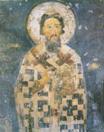 In 1174 was born to Stephen I, the first Serbian Emperor, a son named Rastko. At age 17 Rastko went to the Russian monastery on Mt. Athos and took his monastic vows with the name Sava. Sava’s father also took monastic vows and relinquished his throne. Together they founded the Serbian monastery on Mt. Athos. Sava’s brother, Stephen II, came to power. This was during the time when the throne in Constantinople was held by the Latins after the 4th Crusade, and Stephen asked Pope Innocent III for help. The pope crowned Stephen king; Stephen agreed to obey Rome. The people were very angry. They asked Sava to return. He did and convinced his brother to return to Orthodoxy. The Patriarch of Constantinople, in exile in Nicea, consecrated Sava Archbishop of the new independent Serbian Orthodox Church. St. Sava, who died in 1237, shaped the early Serbian Church through both political and religious strife. But, he was a humble man – a monk – as this well-known story will illustrate:
In 1174 was born to Stephen I, the first Serbian Emperor, a son named Rastko. At age 17 Rastko went to the Russian monastery on Mt. Athos and took his monastic vows with the name Sava. Sava’s father also took monastic vows and relinquished his throne. Together they founded the Serbian monastery on Mt. Athos. Sava’s brother, Stephen II, came to power. This was during the time when the throne in Constantinople was held by the Latins after the 4th Crusade, and Stephen asked Pope Innocent III for help. The pope crowned Stephen king; Stephen agreed to obey Rome. The people were very angry. They asked Sava to return. He did and convinced his brother to return to Orthodoxy. The Patriarch of Constantinople, in exile in Nicea, consecrated Sava Archbishop of the new independent Serbian Orthodox Church. St. Sava, who died in 1237, shaped the early Serbian Church through both political and religious strife. But, he was a humble man – a monk – as this well-known story will illustrate:
One day, as the devil was walking down a steep mountain path, he saw the good and gentle St. Sava, a priest of Serbia, coming up the path. St. Sava greeted the devil warmly and asked him what he would like best to do. The devil answered, “I would like to grow vegetables, if you would help me.”
So St. Sava and the devil became partners. They decided to grow onions. Soon there were beautiful green shoots coming up all over the field. Since they were partners, St. Sava asked the devil which half he would prefer. The devil answered, “I’ll take the half above ground and you can have the part under the ground.” St. Sava agreed. Soon the onions were ripe. Above ground were dried up stalks, but underground were beautiful red onions!
The devil was furious. Next they grew cabbages. The devil insisted on having the part under the ground this time. St. Sava again agreed. Soon the cabbages were grown. St. Sava cut the beautiful heads above ground; all that was left was the brown roots underground for the devil.
Now the devil was even angrier. They decided to grow potatoes. The devil asked for the part above the ground. And, again, the devil got worthless leaves, while St. Sava had a crop of beautiful underground potatoes.
Next they decided to grow wheat. The devil chose the underground part, and Sava was happy to get the beautiful yellow stalks of wheat. The devil was left with worthless stubble.
The devil was in a terrible rage. St. Sava crossed himself and the devil vanished from sight, never to return to match wits with such a good and godly priest.
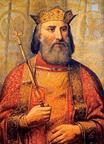 St. Lazar:
St. Lazar:
The year 1389 marked the bitter defeat of the Serbs in the face of the Turks. But, why do the people of Serbia rejoice on that day and celebrate it as a national holiday? Instead of independence (Remember our 4th of July?), the Serbian people on that day lost their freedom.
The Tsar of all Serbia in that day was named Lazar. The ruler of the Turks was Sultan Murat. Murat sent to Lazar a letter. He demanded that Lazar turn over the country to him. If not, he would meet him on the Field of Kossovo and their armies would decide the fate of the nation. But, Lazar know that even more was at stake. The Turks had taken Constantinople and Greece. Serbia was the only country standing between the Turks and the rest of Europe. Lazar had asked for troops to help his small nation fight the mighty Turks. But the other European countries didn’t see their danger; they would not help little Serbia in its time of need. What should Lazar do now? He could not give up without a fight.
The evening before the great battle, as Tsar Lazar had dinner with his wife, Tsaritsa Militsa, she asked him if one of her nine brothers could stay home from the battle tomorrow. Both of them knew that death awaited the men on the battlefield. The Tsar agreed that a brother could stay behind to care for his sister. The next morning, the Tsaritsa waited at the city gates. One by one her brothers and father passed by; one by one they refused to stay behind. They would fight with their Tsar for the beloved land of Serbia!
On the evening before the battle a grey falcon flew away from Jerusalem, carrying a letter from the Virgin Mary on its back. The falcon was Elijah the Prophet. Do you remember his story? He dropped the letter on the knees of the Tsar. As Lazar read the letter, he grew sad. The Theotokos gave him a choice: if he chose an earthly kingdom, he would win the battle, but if he wanted the heavenly kingdom, he should build a silken church on the Field of Kossovo, take Communion, and prepare to die at the hands of the Turks. Lazar knew that an earthly kingdom would last only a short time, but a heavenly kingdom for eternity. He built the silken church and took Holy Communion with all his soldiers.
The next day, at first it seemed as if the Serbian forces could win the battle. The Tsaritsa’s 9 brothers and old father rode gloriously into battle, but all died. As each of Tsar Lazar’s forces entered the fight, they killed many Turks, but there were so many Turks! Then, one of the Tsar’s generals betrayed him and turned and fled from the battlefield. His men followed him. Tsar Lazar lost the battle and his life. But, all was not lost. When all of Europe heard of the Battle of Kossovo, they united and prepared to fight the Turks. The rest of Europe was safe because of the sacrifice of the Serbian nation.
Serbian Orthodox Church:
As with other Balkan countries, Christianity was first introduced in Serbia by the influence of Sts. Cyril and Methodius. The Serbs have, therefore, been mostly influenced by Orthodoxy. But, located between Rome and Constantinople, Serbia has been a target for Latin expansion.
The Crusades affected the political division of Serbia. In 1076, Pope Gregory VII named a Croatian chieftain in the north Bishop of Croatia in the Roman Catholic Church. The southern region, Serbia proper, remained Orthodox, and was first united by Stephen, father of St. Sava.
The Serbian Church suffered the same consequences as those of the other Balkan states under the Turks. Even though they had been given autonomy in 1221 under St. Sava, the Turks insisted on the supremacy of the Patriarch of Constantinople, and it wasn’t until 1897 when the Serbian Church again became self-governing.
The Serbian Church had to face other problems as well. With the growth of the Austro-Hungarian Empire, parts of northern Serbia were annexed and Latinized. Orthodox Christians were oppressed. But, with the dissolution of the Austro-Hungarian Empire at the end of World War I, Serbia regained most of her land. In 1922, the Orthodox Church of Serbia was recognized as a Patriarchate with its Seat at Belgrade.
Into the early 20th century, the Serbian church was inspired by St. Nicholas of Zhicha. Nicholas was born in 1881 on a farm in Lelich. Sickly as a child, he excelled as a student and studied first at St. Sava Seminary in Belgrade, and then at Bern, London, and Russia. He was tonsured a monk and ordained to the priesthood in 1909. Known as the “Serbian Chrysostom,” he was renowned for his sermons, short but taught in a language the people could understand. He traveled during World War I to both England and America as an ambassador for the Serbian 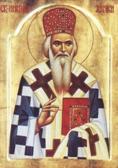 church, and returned to Serbia to be consecrated Bishop of Zhicha. He traveled again to American in 1921, but returned to Serbia, now called Yugoslavia, just before the German invasion of World War II. He was an outspoken critic of the Nazis and was sent to the death camp, Dachau. Nicholas survived and returned to England after his liberation. Later, he traveled again to America, where he served as Dean of St. Tikhon’s Seminary. In 1956, St. Nicholas fell asleep in the Lord, being found kneeling in prayer.
church, and returned to Serbia to be consecrated Bishop of Zhicha. He traveled again to American in 1921, but returned to Serbia, now called Yugoslavia, just before the German invasion of World War II. He was an outspoken critic of the Nazis and was sent to the death camp, Dachau. Nicholas survived and returned to England after his liberation. Later, he traveled again to America, where he served as Dean of St. Tikhon’s Seminary. In 1956, St. Nicholas fell asleep in the Lord, being found kneeling in prayer.
In 1863, there was born to Serbian immigrants in San Francisco a son named Jovan Dabovich. This man became the first American-born Serbian ordained to the priesthood, and later tonsured as a monk, taking the name Sebastian. He is known as the Father of Serbian Orthodoxy in America because of his unceasing apostolic labors, founding many of the Serbian Orthodox churches throughout the USA. He worked with St. Alexis Toth to bring Uniate Christians back to Orthodoxy and opened the doors of Orthodoxy also to Episcopalians. In 1905, Fr. Sebastian was named by Archbishop Tikhon to head the Serbian Mission of the church in North America. He traveled the length and breadth of our continent, by railroad, stagecoach, and by food, visiting parishes, both Serbian and of other ethnic communities. He also compiled one of the earliest English translations of the Divine Liturgy; his books and sermons mark him as an inspired teacher of Orthodoxy. Fr. Sebastian moved to Serbia and ministered there serving the church of Yugoslavia until his death in 1940. In 2007, his remains were moved to San Francisco, to the Church of St. Sava he had founded, and, in 2015, he was canonized as St. Sebastian, with a feast day of November 30.
In the early 20th century, Serbians began migrating to America. There they founded parishes and organized as a Diocese under the Patriarch of Belgrade. Today in the US, some Serbian churches remain under the jurisdiction of Belgrade and some have joined the OCA.
Ethnic traditions:
Serbian food is known for grilled meats, thick soups, goat cheese, and spicy salads. Thick, sweet Turkish coffee is the preferred drink, along with plum brandy.
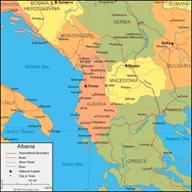
ALBANIA: Geography:
Albania is a small country located between Serbia and the Adriatic Sea. Mountains cover most of the land, with a narrow coastal plain along the Adriatic. Tirana is the capital. Mount Korabit is the highest point in the country. The mountains are rich in minerals and Albania mines chromite, copper, lignite, and nickel and produces petroleum and natural gas. But, most of the population still lives by farming, growing corn, grapes, olives, potatoes, wheat, sheep and goats.
History:
The Illyrian kingdom ruled Albania from 1200-300 BC; in 358 BC they were defeated by Philip of Macedon and ruled by the Greeks until 312 BC. The Romans conquered Illyria in 167 BC and Albania remained in the Byzantine Empire after the fall of Rome. The Ottoman Turks tried over and over to conquer Albania, but failed until about a decade after the death of the national hero, Skenderbeg, in 1468, after even the fall of Constantinople! The Ottoman Turks ruled Albania for 400 years afterwards and 2/3 of all Albanians converted to Islam. To this day, Albania is 70% Muslim and 20% Orthodox (and 10% Roman Catholic).
During the first Balkan War, in 1912, Albania was freed from the Turks, but was occupied by a multitude of foreign powers on both sides during World Wars I and II. The treaty of Bucharest in 1913, ending the Balkan Wars, gave the ethnically Albanian province of Kosova to Serbia; this was repeated after World War I in the Treaty of Paris, giving Kosova to Yugoslavia. Briefly, from 1928-1939 Albania became a monarchy as Ahmet Zogu, the prime minister, names himself King Zog I. In 1944, the Italians and Germans occupied the land but were driven out and the communists under Enver Hoxha took power. They ruled Albania with an iron fist, making all religion illegal and viciously persecuting Christians and Muslims alike, until their fall in 1990. With the fall of communism in both Yugoslavia and Albania, conditions were ripe for the ethnic warfare that broke out in Kosova between Serbs and Albanians.
Albanian Orthodox Church:
With the fall of Communism, the Albanian Church found itself in dire straits. All 1600 churches had been closed or destroyed and only 22 elderly priests remained of the 440 before communism. The Patriarch of Constantinople sent Archbishop Anastasios Yannoulatos to assess the situation. Archbishop Anastasios had been active for decades in countries all around the world. But, this was a challenge – to revive the church without any funds in an impoverished country unstable politically. But, in only 12 years, Archbishop Anastasios has succeeded in building 83 churches, repairing 140 more, restoring 5 monasteries, building a seminary and a convent, as well as schools, medical clinics, children’s homes, nurseries, and camps for all Albanians.
The new democratically elected government tried to get rid of Anastasios with a new constitution demanding that the head of the Orthodox Church be Albanian in origin, but the constitution was defeated by the people. Multiple assassination attempts have failed. When refugees from Kosovo came by the thousands, even though they were Muslims, the Church provided refugee camps, food, and shelter.
In 1998, the Orthodox Church of Albania was granted autocephaly – self-government. Archbishop Anastasios is now Archbishop of Tirana (the capital), Durres, and all Albania, with a Holy Synod composed of other bishops and metropolitans.
Ethnic traditions: Albanian food is mostly made up of bread and dairy products – milk and cheese. Ethnically, Albanians are divided into two groups, Ghegs and Tosks, depending on the Albanian dialect they speak. There are also ethnic Greeks.
Quiz Questions: Compare and contrast the history, religion, and culture of these four countries.